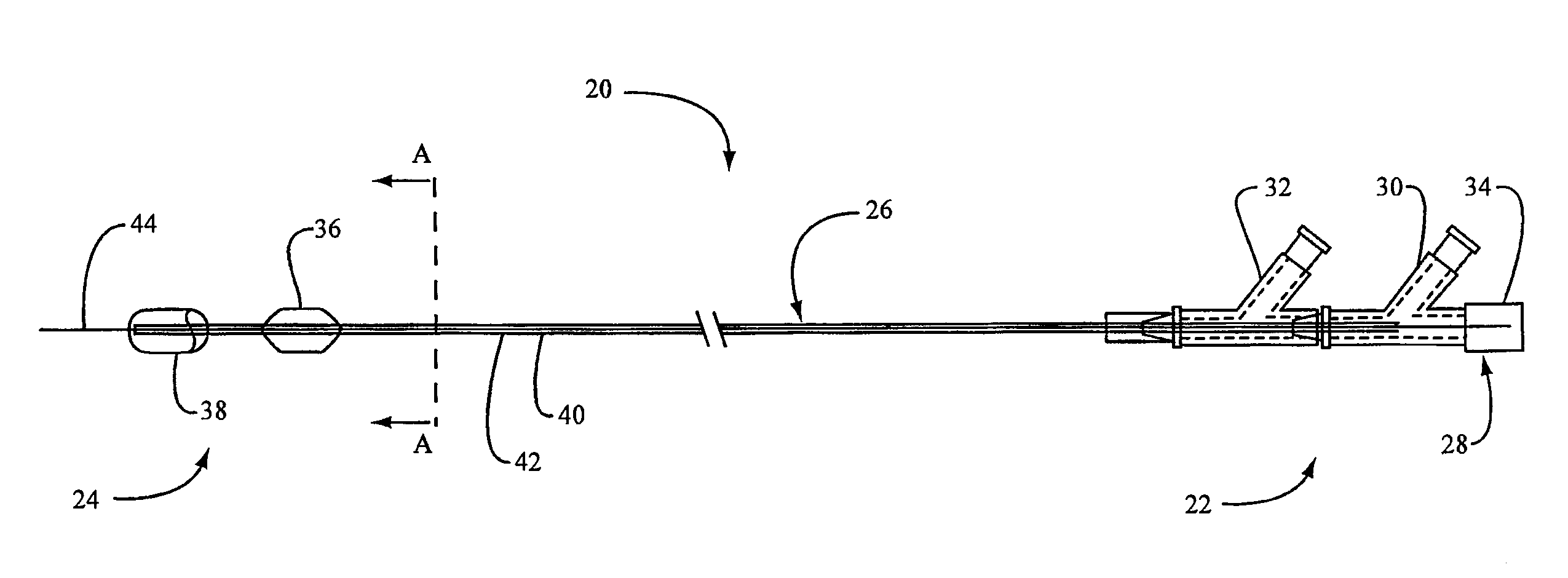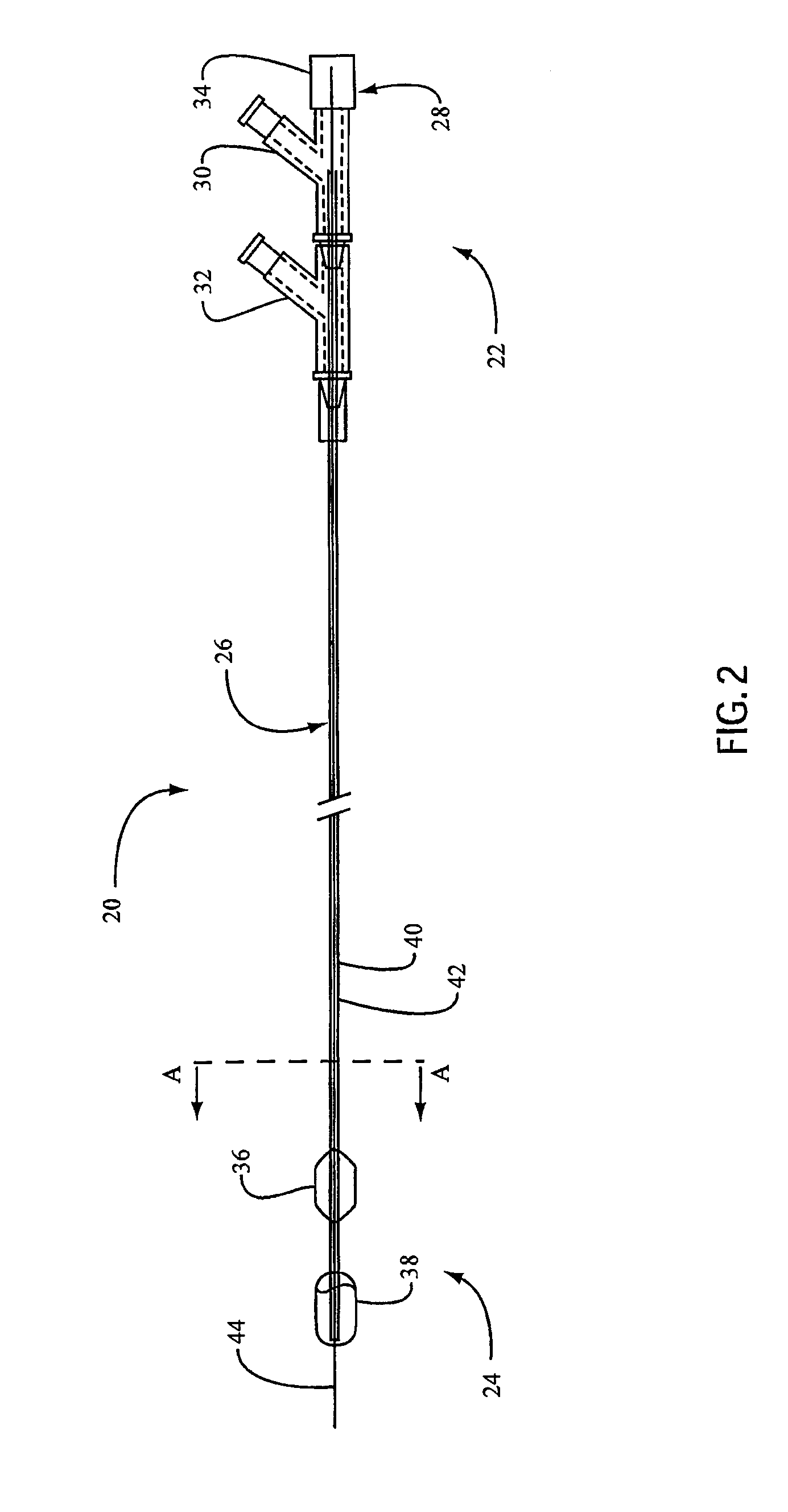Embolic Protection Device Having Expandable Trap
a protection device and trap technology, applied in the field of total capture angioplasty device and trap, can solve the problems of emboli, stroke, emboli, emboli, etc., and achieve the effect of increasing suction, facilitating suction, and increasing suction
- Summary
- Abstract
- Description
- Claims
- Application Information
AI Technical Summary
Benefits of technology
Problems solved by technology
Method used
Image
Examples
embodiment 120
[0088]In operation, the valve embodiment 120 is actuated by longitudinally moving the guidewire 44 relative to the catheter wall 48. That is, pulling the guidewire 44 in a proximal direction relative to the catheter wall 48 causes the generally planar engagement surface 126 to sealably engage the abutment 121, which prevents fluid from flowing through the circular flow channel 128. Pushing the guidewire 44 in a distal direction relative to the catheter wall 48 causes the stopper 122 to disengage from the abutment 121, which allows fluid to flow through the circular flow channel 128.
[0089]Other valve embodiments 120 capable of being actuated by longitudinal motion are also within the scope of the present invention. For example, the stopper 122 may be rotated 180 degrees so that the conically shaped surface 124 engages the abutment 121, rather than the generally planar engagement surface 126. These embodiments may be desirable because the conically shaped surface 124 will self-center ...
embodiment 20
[0095]FIG. 18 is a sectional view of an angioplasty device 20 embodiment for use in retrograde applications (see FIG. 1 of U.S. Pat. No. 4,794,928 for conceptional orientation, which is herein incorporated by reference). This embodiment comprises a separate catheter 160 for the balloon 36 and for the inflation / deflation lumen 40. This catheter 160 has a first wall 162, a second wall 163, and an end wall or plug 164. In operation, the trap 38 in this embodiment is actuated by relative rotational and / or longitudinal motion between the exterior wall 46 and the first wall 162 of the catheter 160. Like the embodiments in FIGS. 14-17, this angioplasty device embodiment 20 can be loaded over a separate guidewire (not shown) or catheter (not shown) that has previously been inserted into the patient using lumen 150 and opening 152. Also like the embodiments in FIGS. 14-17, the trap 38 in this embodiment can be actuated using relative rotational motion or a combination of relative longitudina...
embodiment 38
[0096]FIG. 19 is a sectional view of an angioplasty device embodiment having a coupling device 190 with four radially spaced sockets 189. FIG. 20 is a sectional view of the coupling device 190. The coupling device 190 in this embodiment may be any device that prevents the balloon catheter 102 from rotating relative to the trap catheter bundle 100 (or translating, if used with the trap embodiment 38 described with reference to FIGS. 21 and 22). These embodiments are desirable because the trap catheter bundle 100 and the balloon catheter bundle 102 may be manufactured separately, then combined as needed.
[0097]FIG. 27 depicts an alternate embodiment in which a second group of struts 49a connect the coupling device 190 to an end 191 of the trap catheter bundle 100. In operation, the trap catheter bundles 100 in FIGS. 19 and 27 may be inserted over an in-place balloon catheter 102 and then either removed along with the balloon catheter 102 or by itself, depending on the configuration of ...
PUM
 Login to View More
Login to View More Abstract
Description
Claims
Application Information
 Login to View More
Login to View More - R&D
- Intellectual Property
- Life Sciences
- Materials
- Tech Scout
- Unparalleled Data Quality
- Higher Quality Content
- 60% Fewer Hallucinations
Browse by: Latest US Patents, China's latest patents, Technical Efficacy Thesaurus, Application Domain, Technology Topic, Popular Technical Reports.
© 2025 PatSnap. All rights reserved.Legal|Privacy policy|Modern Slavery Act Transparency Statement|Sitemap|About US| Contact US: help@patsnap.com



